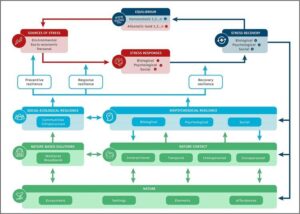
Blog Arjan Berkhuysen, november 2023
Nature as a source of resilience. What a great title! I recently read it in a post by Agnes van den Berg, a researcher and pioneer in the field of 'nature and health'. She has co-authored a new scientific article that describes how nature as a source of resilience can be used not only for landscape planning but also for individuals. It describes how contact with nature can help people in adversity, such as those experiencing grief. For me, it's a fantastic article because my work on NL2120, Nature For Health, Earthfulness, and the grief path on Terschelling Walk of Grief all came together so beautifully!
The authors of the article see resilience as a stock of resources that can be used when things go wrong. This can happen at a collective level, for example, by designing natural areas to capture water during floods or combatting heat stress with more trees in the city (Nature-based Solutions). But it can also happen at an individual level. They speak of biological, psychological, and social resilience in this regard.
This 'biopsychosocial' natural resilience, according to the article, can be used in three phases of adversity: preventive, reactive, and restorative. Resilience against stress plays a central role in this. It is already well-known that prolonged stress can be quite unhealthy and can lead to illness. Stress can be caused by the environment (e.g., earthquakes), by socio-economic factors (e.g., job loss), or by personal experiences such as painful experiences or relationship problems. Your stock of resilience resources then determines how you can cope with that stress.
In this article, the authors base their ideas on biological resilience sources, such as physical health, psychological sources, such as an open attitude to change, and social resilience sources, such as general trust. The combination of these sources determines your resilience in adversity. And here comes the basis of the theory of this article. The authors assume that these 'biopsychosocial resilience sources' can be strengthened with nature. Personally, I can completely imagine that. In their theory, which they call the 'Nature-based biopsychosocial resilience theory (NBRT),' they beautifully relate landscape-wide resilience with Nature-based Solutions to individual resilience (see the diagram below).

The authors support the theory with various examples, although they immediately admit that it is not exhaustive. They identify at least five systems that promote biological resilience: in green areas, there is usually less pollution; the body's immune system functions better; people in green areas generally experience less stress; individuals in green spaces are more active, leading to slightly better fitness and physical strength. Psychologically, it involves emotional and cognitive resilience. There is ample evidence that nature experiences can bring joy and reduce negative emotions. Cognitive resilience is mainly about the ability to control attention, concentration, and studies that show nature can boost self-confidence. Social resilience focuses on studies demonstrating that people in nature tend to behave more socially. This may be because people in groups in nature communicate and collaborate better, leading to increased trust and respect. A new finding for me was a study from 2022 suggesting that people in 'green areas' seem to be less lonely, especially those living alone. It sounds paradoxical, but you would probably need to read the study for a full understanding.
With all these positive aspects regarding the potential of natural resilience, the inevitable question arises: what can be done? The authors describe three levels of interventions. The first involves interventions for entire communities, such as creating parks. The second focuses on specific population groups with clear needs, such as people who are constantly busy. Interventions for this group include forest bathing and group walks in nature. The third level involves individuals with medical issues, such as depression. In this case, interventions include therapy or mindfulness in nature. Regardless of the level, the most effective interventions involve contact with other people (in groups, communities, or close relationships).
The article wouldn't be a scientific article without ending with suggestions for further research. There is a need for deeper exploration of the relationships between different forms of natural resilience. And, of course, it requires more understanding of how to practically build natural resilience.
It is evident that I am enthusiastic about this article. Not necessarily because I have read so much new information, but because it provides a unifying framework for the avalanche of new publications we have seen recently on resilience, natural solutions, and connectedness to nature. That is fantastic, but you could almost miss the forest (bath) for the trees. Agnes van den Berg expresses it beautifully in her post: "Nature is still underutilized as a source of resilience. While it can be such a great support and even a friend in times of need."
Arjan Berkhuysen, november 2023
